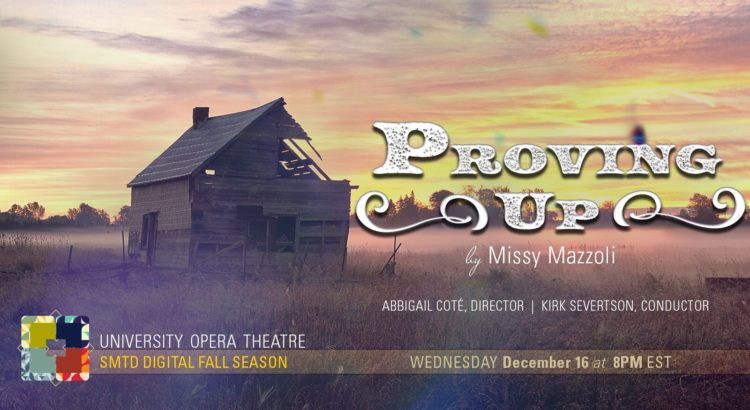Piercing vocals and eerie lighting fill the Power Center arena. Performers pace the stage, desperately chanting a seemingly impossible list of requirements for obtaining the deed to their land. Though physically distanced, each character’s life is hopelessly entangled with every other person on the stage. A show that had once started in warm yellow light devolves to a harsh inky blue, leaving audience members with a kind of uneasiness that can’t be shaken. This is emotional opera theatre in the age of a global pandemic. This is the University Opera Theatre & University Symphony Orchestra production, Proving Up.
Premiering just last night on December 16th, audiences across the region were given the chance to watch Proving Up, an opera included in SMTD’s winter digital series. Taking places in the early 1870s at the dawn of the Homestead Act, the opera follows a family of Nebraskan homesteaders in their quest to obtain the deed to their farmland– to “prove up”.
The chamber opera begins in a way that seems mostly normal to audiences. The orangey-yellow set feels warm and welcoming, inviting viewers into the family’s world and their quest for the American Dream. Almost obsessively, the family repeats the four requirements that need to be met in order to get their land deed: a house of sod, acres of grain, a five year history on the land, and a window of glass. The last requirement is the most elusive, as it is the very thing that leads to the family’s eventual demise. With every line, the atmosphere on stage grows colder– a mother makes a haunting confession, a father commits a desperate crime, and a ghostly set of sisters weave back in forth between reality and the beyond. Nothing about the world on stage is truly normal, and it is almost impossible while viewing to ignore the sense that the family is being controlled by events just outside of their sight. Though set in what may be a familiar period in American history, Proving Up is anything but expected.
As the opera continues, it becomes apparent that every creative decision made by performers and production team members alike was made with the audience’s discomfort in mind. Scenic Designer, Henry Pederson, has created a set that just slightly exposes the industrial innerworkings of the Power Center itself. Lighting Designer, Harrison Hoffert, lights the performers in a way that pointedly foreshadows their demise. Remaining in line with COVID-19 safety guidelines, the closest performers stand an achingly far 12 feet away from one another, even in times of immense emotional distress. Though subtle details exist throughout the show, it isn’t until the last two acts that audience members find such details coming together to reveal just how warped this world is. Left in an initial hazy confusion, an understanding of events doesn’t dawn on viewers until the true tragedy is centerstage.
Proving Up is a morbidly beautiful opera. The talented performers and members of the creative team work have worked harmoniously to create a cohesive yet grating environment for the heart of the show to live in. With every scene, viewers pick up on yet another detail in a complicated series of events, eventually resulting in an emotionally-charged finale that will leave some unsettled even hours after the curtain falls. This modern age opera expertly combines some of the best things that art has to offer: emotion, drama, and story-telling. Those looking for an evocative show must look no further: Proving Up draws on an intangible kind of fear that audience members will find nowhere else.


